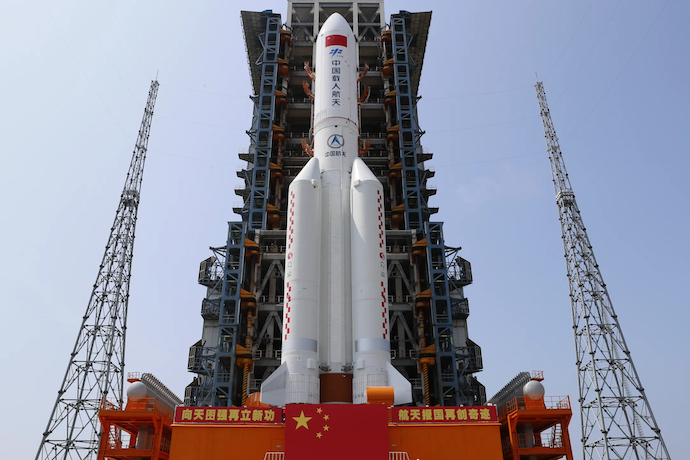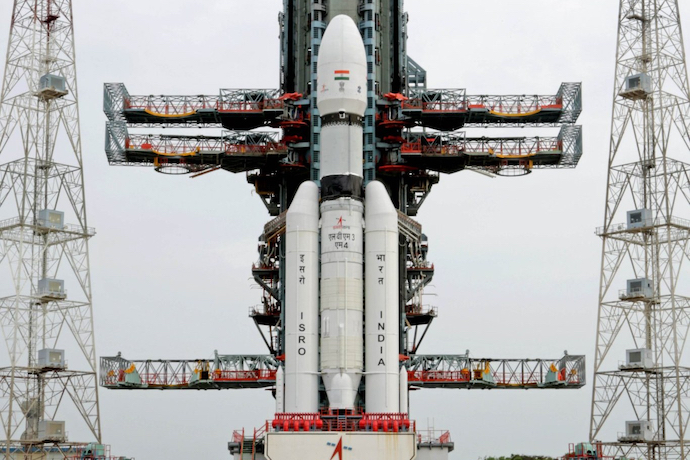
Tech
BRICS is Winning the New Space Race
The Texas Space Commission was recently unveiled by Governor Greg Abbott at NASA’s Johnson Space Center in Houston, Texas. Abbott’s goal is to cement Texas’ position as a national leader in the space industry. At the same time, SpaceX plans its next Starship launch for early May at the company’s launch site in Boca Chica, Texas. The fully stacked 121-meter or nearly 400-foot-tall Starship platform is vital to NASA’s future moon missions.
In a significant update on America’s lunar ambitions, NASA’s Artemis program faces altered timelines as Starship and Lockheed Martin’s Orion spacecraft—central to the mission of returning Americans to the Moon—confront technical and logistical challenges. The timeline for America’s next Moon landing, initially slated for 2024, has now been deferred to late 2026 at the earliest.
The Orion spacecraft, which successfully completed an uncrewed lunar orbit during the Artemis 1 mission in 2022, has since grappled with technical postponements. Current plans anticipate that four NASA astronauts will orbit the Moon no earlier than September 2025, setting the stage for a subsequent landing on the lunar surface using Starship no earlier than 2026. As per the contract stipulations with NASA, Elon Musk’s SpaceX is mandated to accomplish an uncrewed lunar landing with Starship prior to any crewed attempt.

Simultaneously, the geopolitical landscape of space exploration is witnessing a burgeoning alliance within the BRICS consortium. Notably, nations such as Saudi Arabia, Egypt, the United Arab Emirates, Iran, and Ethiopia are in talks to support collaborative lunar ventures spearheaded by China and Russia, potentially accelerating their position in the extraterrestrial exploration domain.
Since Beijing’s December 2013 Moon landing, China’s space-related accolades include building a crewed space station called Tiangong, sending a robotic rover to Mars, and becoming the first country to make a controlled landing on the far side of the Moon. Their 2022 white paper focuses on these elements of human spaceflight and lunar and planetary exploration missions, and their list of achievements in these areas continues to stack up. Just last month, China launched a relay satellite and two mini-satellites for the Chang’e 6 located on the far side of the Moon. All three probes successfully entered lunar orbit in late March.
Amid geopolitical tensions reverberating through terrestrial alliances, the fabric of international cooperation in space exploration is undergoing a profound reconfiguration. In a move reflecting broader diplomatic estrangements, the European Space Agency has severed its Russian partnerships in response to the conflict in Ukraine. Contrasting this Western realignment, Beijing maintains its collaborative stride with Moscow, undeterred by terrestrial disputes.
Russia, with a storied legacy in space stations from the defunct Mir to the International Space Station (ISS), now aspires to reinstate its autonomy in the cosmos. In a declaration resonating with the ambition of Soviet-era space endeavors, Russian President Vladimir Putin has signaled the inauguration of Russia’s new orbital platform, targeted to be partially operational by 2027. This endeavor marks a significant pivot from international dependencies toward a sovereign orbital outpost.
Simultaneously, in seeking partners for this audacious project, Moscow has initiated negotiations within the BRICS assembly, contemplating a broader consortium that may involve emergent space-faring nations in a shared space station endeavor. This development could potentially shift the current dynamics of international space cooperation, presenting new vectors of collaboration in the high frontier.
China and Russia also have their own Moon plans, notably the Lunar Research Station (ILRS) project. The two countries signed an agreement in 2021 to build a “comprehensive scientific experiment base” on the lunar surface and or in lunar orbit in order to carry out “multidisciplinary and multiobjective scientific research activities.” Soon after, South Africa, Egypt, Venezuela, Pakistan, Azerbaijan, and others expressed an interest or signed onto the project.

Meanwhile, Beijing’s reliable and evolving Long March rocket family has helped launch satellites for African countries like Algeria, Ethiopia, Nigeria, and Sudan, as well as Egypt which will be hosting the African Space Agency headquarters in Cairo. China began a satellite assembly and test center in Cairo in 2019.
Washington is particularly concerned about Beijing and Moscow’s Iranian space cooperation. Tehran’s space program is deeply troubling to the U.S. because of its larger geopolitical implications. On February 29, Russia launched an Iranian-made research satellite into orbit, and in January, Iran claims it launched three satellites into orbit. Tehran plans for its Chabahar Space Center in southeast Iran to be the biggest space launch site in West Asia.
The other BRICS members like Brazil, India, Saudi Arabia, and the UAE are in a precarious spot. They are signatories of the U.S. State Department and NASA’s Artemis Accords, the non-binding bilateral arrangements related to expected norms in outer space. This is forcing them to perform a balancing act with the U.S. and China/Russia.
India’s space ambitions have soared remarkably since the 1970s, with the Indian Space Research Organisation (ISRO) at the helm. In a strategic push for interplanetary acclaim, India triumphed with its maiden voyage to Mars in 2013, a narrative underscored by an admission from ISRO’s chairman: the mission was partly fueled by the drive to outpace China after its Martian aspirations, tethered to the Fobos-Grunt mission of 2011, faltered.
A decade of technological advancements and strategic planning culminated on 23 August 2023, when India’s lunar probe made its historic touchdown on the Moon’s surface—an event meticulously timed with the annual BRICS Summit, signaling India’s elevated status in the space race. This lunar feat arrived on the heels of Russia’s Luna 25 mishap, casting a stark contrast between the two space-faring nations.
In a subsequent strategic alliance, India announced in December an initiative fostered with American expertise: the training and dispatch of an Indian astronaut to the International Space Station (ISS) by the end of 2024, marking yet another milestone in India’s ascendant space narrative. This collaboration stands as a testament to the growing international partnerships defining the new age of space exploration.

Brazil has been orchestrating a sophisticated space partnership with both American enterprises and the BRICS coalition. The Sino-Brazilian chapter in this global space saga has been unfolding for over three decades, encapsulated by the China-Brazil Earth Resources Satellite (CBERS) project—an ambitious collaboration that bore fruit with the inaugural launch in 1999. This initiative has since been instrumental in the development of six earth-observation satellites, cementing the role of the two nations in the vanguard of spaceborne environmental monitoring.
This enduring partnership underpins the BRICS Committee on Space Cooperation, with a pointed emphasis on collaborative observation and the open exchange of satellite data amongst the BRICS Remote Sensing Satellite Constellation—a powerful tool in the shared stewardship of Earth’s natural resources.
Yet, Brazil’s space strategy has deftly embraced versatility; the country ratified a pivotal agreement in 2019, facilitating the influx of American space technologies—a move that strategically positions Brazil as a nexus for space launches within the Western hemisphere. Cementing its commitment to international space collaboration, Brazil became a signatory of the Artemis Accords in 2021, a gesture that solidifies its aspirations to be a part of humanity’s next lunar chapter. This alignment with the Accords signifies Brazil’s nuanced navigation of space diplomacy, balancing relationships with both historical partners and emergent alliances.
Saudi Arabia, which signed the Artemis Accords in July 2022, has a similar story. Despite being a long-time American ally, Riyadh has a rich space history with China and Russia. The Arab nation is also in active negotiations with Chinese space companies for a deal covering technology transfer for satellite software, among other space activities. The oil-rich Kingdom has ambitious goals including more Moon involvement, and one day having its indigenous launch capabilities. The Saudis recently made an unprecedented move via a filing to the United Nations to withdraw from the 1979 Moon Agreement, the first country to do so. Three Saudi Arabian nationals have already made it into space.
The UAE’s space aspirations reached a new zenith with its Mars Hope Probe orbiting Mars in February 2021. Further expanding its cosmic footprint, the UAE’s University of Sharjah has joined the China-Russia-led International Lunar Research Station project. Simultaneously, the Mohammed bin Rashid Space Centre is broadening its partnership with NASA, providing a key airlock component for the Artemis Gateway lunar station, alongside international agencies like the Canadian, European, and Japan Aerospace Exploration Agencies.
China’s space strategy is casting its gaze beyond NASA, identifying the burgeoning capabilities of private sector giants—SpaceX, Lockheed Martin, Boeing, Northrop Grumman, Blue Origin, and Axiom Space—as the primary sources of competitive tension. The nation has voiced concerns over SpaceX’s Starlink constellation, joining Russia and Iran in denouncing the project for its potential repercussions on global security.
Despite achieving a flawless launch record in 2023, China is not resting on its laurels. The country is intensively working to pivot towards reusable rocket technology by 2026, a feature emblematic of SpaceX’s innovation, and is setting ambitious goals to dispatch Chinese astronauts to the lunar surface by 2030.
While facing contrasting fortunes characterized by periodic delays, U.S. space agencies could witness China’s swift execution of expansive projects—a proficiency that might soon manifest in the augmentation of its orbital outpost from three to six modules. Speculation is ripe that the forthcoming Chinese ventures—Mengzhou (Dream Vessel), the lander Lanyue (Embracing the Moon), and the formidable Long March 10 rocket—may well be the vessels that inscribe Chinese footprints on the Moon, continuing the nation’s storied journey into the cosmos.
Overall, it appears there is no stopping this new space race. It is a race requiring a vast amount of money and brain power, hence the necessity for space diplomacy. The expanding BRICS alliance does pose formidable competition for America. This means space diplomacy will grow in foreign policy importance. Artemis is key for the U.S., and with 38 countries currently signed up. Washington and NASA will want to keep these countries on board, or better yet expand the list of partners, like it did this week with Sweden and Switzerland becoming the newest signatories.
Regardless of the space race outcome, experience shows scientific innovation in this arena nearly always means a positive return on investment for humanity and our future generations.
Going back to the Moon and beyond will be difficult. It will be expensive. But as a species, it is a journey we must take.

